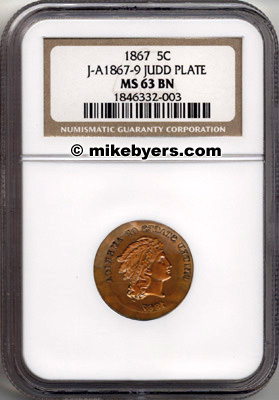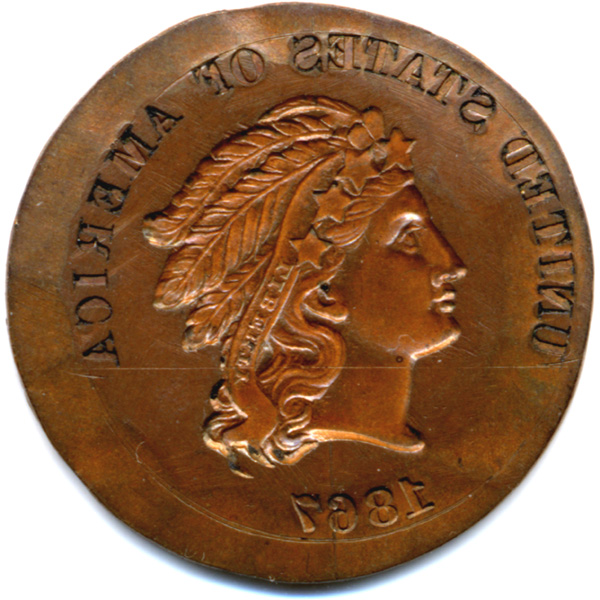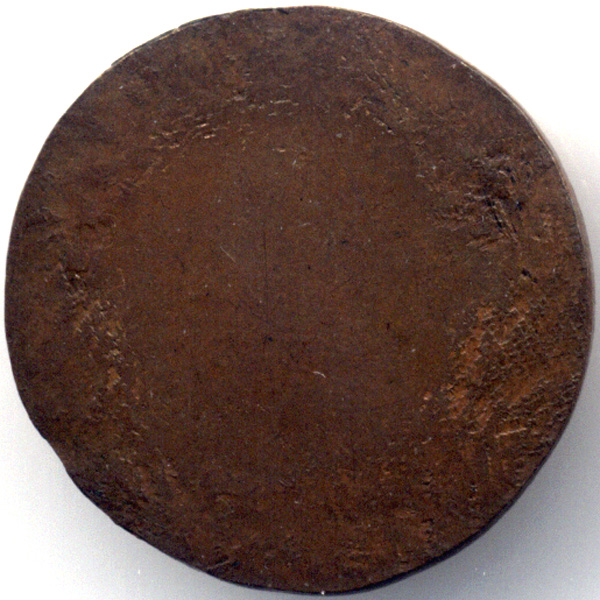Struck in Copper
Judd Plate Coin J-A1867-9
NGC MS 63 Brown
UNIQUE
SOLD

Judd 8th Edition Plate Coin JA1867-9 page 313.
Listed in Pollock #3311.
Why produce an aluminum five-cent pattern? The nickel 5-cent piece had been introduced in 1866, and it soon became clear that the dies used to strike the new nickels were breaking at an alarming rate because of the high degree of hardness of the new nickel planchets. In response to this problem Mint Engraver James B. Longacre began work on the design for a new aluminum five-cent piece that would solve the problem of excess die breakage because aluminum is a much more malleable metal than nickel. Counterfeiting would also be difficult because aluminum is such a light metal. In addition, Longacre was interested in producing a coin whose metal value would be the same as its face value, and at the time the value of aluminum was such that a coin with the diameter of a $5.00 gold piece (21.6mm, slightly larger than that of a nickel) would suffice.
This is part of the design for the obverse of the aluminum 5 Cent pattern. Longacre was already well known because he had designed so many U.S. coins that were in current production: the Indian Head Cent, the 2 Cent piece, the 3 Cent piece, the Shield Nickel and the $20.00 Gold piece were all designed by him. For the obverse of his aluminum 5 Cent pattern he adorned a youthful Head of Liberty with a headdress possessing 4 feathers, 4 stars and a ribbon inscribed with the words UNION & LIBERTY. Around the head were the words UNITED STATES OF AMERICA, and below the head was the date, 1867. The aluminum pattern was struck with a plain edge (Judd 561, Pollock 622) or a reeded edge (Judd 562, Pollock 623), and came to be known as the "Indian Princess" pattern.
This unique obverse hub trial is a significant part of numismatic history. This piece was struck in copper because that was the metal of the blanks available at the Mint for this purpose. The punches used to make hub trial pieces were intended to be used to make working dies, with the result that the design elements that appeared on a hub trial were both incused and reversed. Hence the legend, the date and the Liberty head all appear "backwards" and "indented" on this piece as compared with the finished die-struck pattern.
On this piece there is a circular scribe line around the outside of the letters of the legend to serve as a guide for the positioning of the hand-punched letters. A straight scribe line passes horizontally across the piece to demarcate the beginning and ending points of the legend. This specific hub trial is listed as Pollock-3311, and is pedigreed back to L.S. Werner (1955).
Of particular interest, a comparison of this hub trial with the final aluminum pattern shows that Longacre changed elements of the headdress and ribbon prior to producing the pattern. On the headdress he rotated the lower 3 stars so that on the pattern a point of each star aims towards the central part of Liberty's face (they don't do this on the hub trial). On the ribbon the finished pattern has the words UNION & LIBERTY but the hub trial has only the word LIBERTY. This hub trial gives us a glimpse into Longacre's creative process by illustrating a design that he made, and then personally changed before he arrived at his final product.
Considering that there are several thousand different U.S. Patterns known and 272 Splashers known, there are only 43 Hub Trials known for the entire U.S. Pattern series.


Featured on uspatterns.com:




